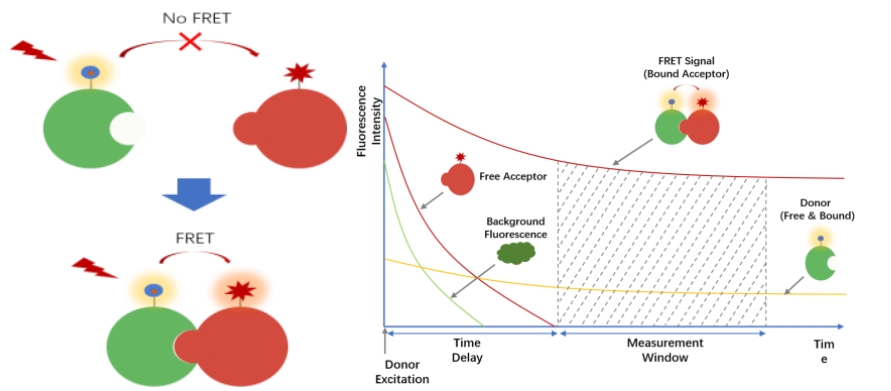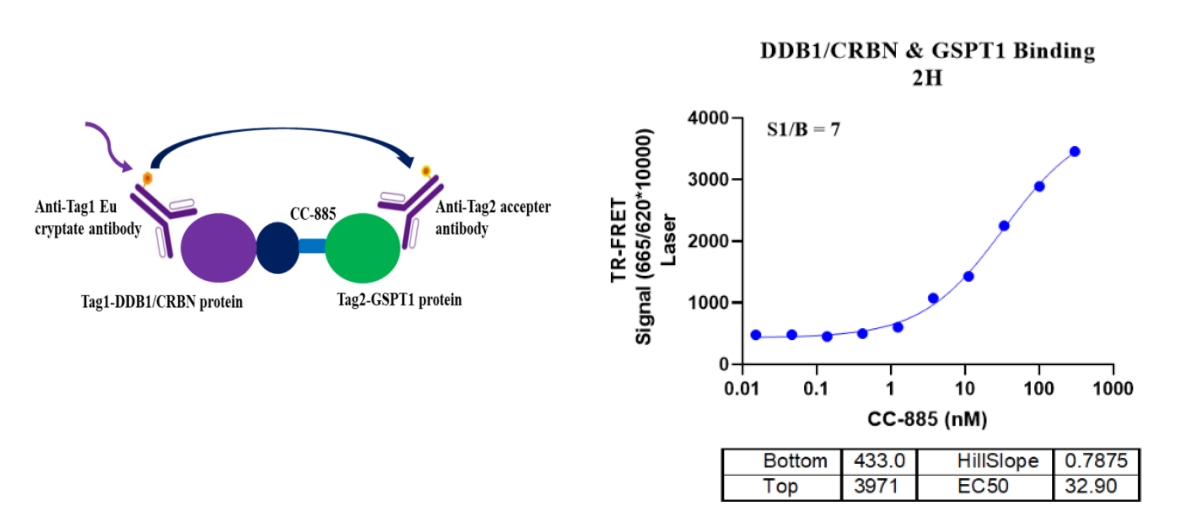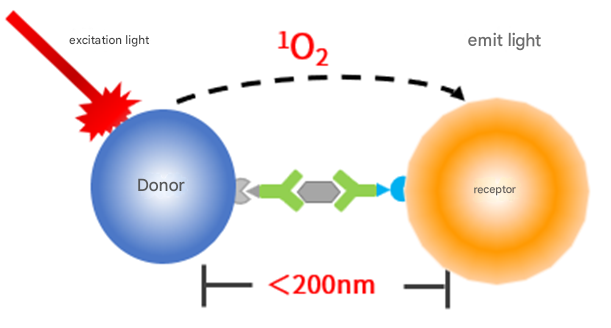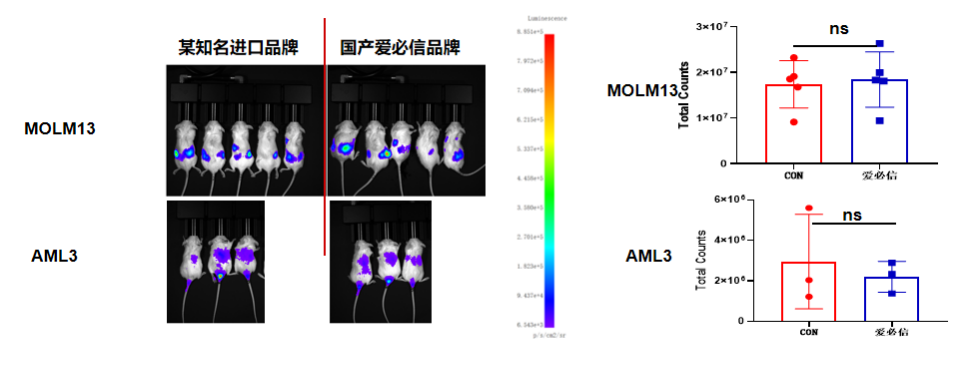- Cart 0
- English
Abbkine Homogeneous Detection Solutions
TR-FRET(Time-Resolved Fluorescence Resonance Energy Transfer)
-
Fluorescence Resonance Energy Transfer (FRET): When a fluorescent molecule (donor) absorbs light energy, it can non-radiatively transfer this excited energy to another molecule (acceptor), provided that the acceptor is in close proximity to the donor (typically within a range of 1-10 nanometers), and there is an overlap between the donor's emission spectrum and the acceptor's excitation spectrum.
-
Time-Resolved Fluorescence (TRF): By measuring the decay of fluorescence after the excitation light source has been stopped, it is possible to distinguish between short-lived background fluorescence and long-lived signal fluorescence. TR-FRET typically employs chelates of lanthanide elements (such as europium or terbium) as long-lived donor fluorophores.
-
Energy Transfer Process: In TR-FRET, after the donor is excited, if it is in close enough proximity to the acceptor, energy is transferred to the acceptor, causing it to emit fluorescence as well. By detecting the fluorescence after a delay following excitation, it is possible to effectively reduce background interference.

-
Simple Operation: No complex washing steps are required, making it easy to automate.
-
Wide Linear Range: Capable of detecting both high and low concentrations of samples with a broad linear detection range.
-
Rapid Detection: Detection can be completed in as little as 1 hour, significantly improving experimental efficiency.
-
Low Background Signal: The long fluorescence lifetime of lanthanide elements allows for delayed detection after excitation, eliminating interference from short-lived fluorescence.
TR-FRET Product Recommendation List
| Product Number | Product Name | Application |
|
Human Total IgG Kit (Assay Pro) |
Detects Human IgG antibodies in cell culture supernatants |
|
|
Human IgG Sandwich Assay Kit |
Detects the concentration of human IgG antibodies or hFc-tagged proteins in cell culture supernatants |
|
|
TR-FRET Kinase-TK Assay Kit |
Activity detection and inhibitor screening of various kinases |
|
|
Human KRAS WT&cRAF Binding Kit |
Rapidly detects small molecule inhibitors that interact with KRAS-cRAF |
|
|
Human KRAS G12C&cRAF Binding Kit |
||
|
Human DDB1-CRBN&GSPT1 Binding Kit |
Detects small molecules that interact with the DDB1/CRBN complex and GSPT1 |
|
|
Human TNF-α/TNFR1 Binding Kit |
Determines the interaction between TNF-α and TNFR1 |
|
|
Human IL4/IL4R Binding Kit |
Determines the interaction between cytokine interleukins and their receptors, as well as their inhibitors and antibody (blockers) |
|
|
Human IL10A/IL10RA Binding Kit |
||
|
Human BCL-XL/CRBN PROTAC Binding Kit |
Detects small molecules that interact with the DDB1/CRBN complex and BCL-XL |
|
|
Human BCL-XL/VHL PROTAC Binding Kit |
Detects small molecules that interact with the VHL complex and BCL-XL |
|
|
Human BRD4/CRBN PROTAC Binding Kit |
Detects small molecules that interact with the DDB1/CRBN complex and BRD4 |
|
|
Human Epigeneous Bromodomain Binding Kit |
Determines the interaction between BRD4 and [ILYS(5,8,12,16)AC] H4(1-21) peptide, as well as their inhibitors and antibody (blockers) |
|
|
PD1/PD-L1 and more TR-FRET products... |
||
Data Example(abs560012 an example)

* The above data cannot replace the data obtained from experiments and are provided only as examples. Results may vary depending on the TR-FRET compatible instrument used.
Homogeneous Chemiluminescent Assay (HICA)
HICA is a chemiluminescent technology based on nanoparticles. It detects interactions between biomolecules via energy transfer between two types of microspheres (donor and acceptor microspheres). The principle is as follows:
-
Donor Microspheres: Coated with a photosensitizer (e.g., phthalocyanine dye). When excited by 680 nm red light, they convert oxygen molecules in the environment into high-energy singlet oxygen.
-
Acceptor Microspheres: Coated with a luminescent agent (e.g., a dimethylthiophene derivative) and a rare-earth chelate (e.g., europium). When singlet oxygen diffuses to these microspheres, it excites the luminescent agent to produce fluorescence at around 610 nm.
-
Energy Transfer: When the two types of microspheres are brought within 200 nm of each other due to biomolecular interactions (e.g., antigen-antibody binding), singlet oxygen can transfer from the donor to the acceptor microspheres, producing a chemiluminescent signal.

Technical Advantages
-
High Sensitivity: Energy transfer from singlet oxygen enables detection limits as low as the femtomolar range.
-
Low Background: The detection wavelength is longer than the excitation wavelength, reducing interference from impurities.
-
Easy Operation: No washing steps are required, making it suitable for automated and portable detection.
-
Miniaturization: Ideal for developing miniaturized, high-throughput detection platforms.
HICA Product Recommendation List
| Product Number | Product Name | Application |
|
Human IL-10 Kit (HICA) |
500T/2000T/10000T |
|
|
Human IL-17A Kit (HICA) |
500T/2000T/10000T |
|
|
Human IL-2R Kit (HICA) |
500T/2000T/10000T |
|
|
Human TNF-α Kit (HICA) |
500T/2000T/10000T |
|
|
Human TNF-β Kit (HICA) |
500T/2000T/10000T |
|
|
Mouse IFN-γ Kit (HICA) |
500T/2000T/10000T |
|
|
HICA Human IgG Kit |
200T/500T/5000T |
|
|
IL-5\IL-12p70 and more related indicators... |
||
Data Example(abs560034 an example)
 |
Lower Detection Limit: 0.2–3 pg/mL for different matrices Dynamic Range: 0–100,000 pg/mL Linear Range: 0.39–10,000 pg/mL
High Concentration CV Value: 1.5–5% Recovery Rate: 90–110% Cross-Interference Rate: 0% for five tested samples
|
Bioluminescence
-
Enzyme-Substrate Binding: Firefly luciferase binds to its substrate luciferin. The enzyme then combines with ATP (adenosine triphosphate) and luciferin to form an enzyme-substrate complex.
-
Oxidation Reaction: Catalyzed by luciferase, luciferin reacts with oxygen to form oxyluciferin. During this reaction, chemical energy is converted into light energy, releasing a photon.
-
Light Production: The emitted photon produces visible light, typically a yellow-green light with a wavelength of around 560 nm. This light signal can be detected by devices such as luminometers or imaging systems.

Bioluminescence Detection Product Recommendation List
| Catalog Number | Product Name | Specification | Application |
|---|---|---|---|
| ATP Microplate Assay Kit |
96T |
Assess cell proliferation, damage, activation, and intracellular granule release | |
| 2D Luminescent Cell Viability Assay |
50mL×2 |
Detect bioactive factors, screen anti-tumor drugs, and perform cell proliferation and toxicity tests | |
| 2D/3D/Organoid ATP Viability Assay Kit |
10mL |
Assess cell numbers in organoids | |
| 3D Luminescent Cell Viability Assay |
50mL×2 |
Detect bioactive factors in 3D cell cultures, screen anti-tumor drugs, and perform cell proliferation and toxicity tests | |
| ATP Synthase Microplate Assay Kit |
96T |
Detect ATP synthase activity, study energy metabolism, and screen drugs | |
| Dual-Luciferase Reporter Assay Kit |
100T |
Assess the transcriptional regulation of target genes by drug treatment | |
| Secreted Luciferase Reporter Assay Kit |
200T |
Detect reporter genes | |
| NLuc Luciferase Reporter Assay Kit |
500T |
Analyze reporter genes | |
| One-Step Firefly Luciferase Reporter Assay Kit |
50T |
Gene regulation and drug screening | |
| Firefly Luciferase Reporter Assay Kit |
50T |
Detect reporter genes | |
| ATP/ADP Ratio Chemiluminescent Assay Kit |
96T |
Measure the ATP/ADP ratio in cell samples to analyze cell status | |
| D-Luciferin Potassium Salt |
25mg |
In vitro bioluminescent detection and in vivo imaging analysis | |
| D-Luciferin Sodium Salt |
100mg |
In vitro bioluminescent detection and in vivo imaging analysis |
Data Example(abs42075819 an example)

Detection Consumables
| Catalog Number | Product Name | Specification |
|---|---|---|
|
Microplate (384-well, white, flat-bottom) |
40plates/box |
|
|
Microplate (96-well, white, flat-bottom) |
50plates/box |
Absin provides antibodies, proteins, ELISA kits, cell culture, detection kits, and other research reagents. If you have any product needs, please contact us.
|
Absin Bioscience Inc. |
 Follow us on Facebook: Absin Bio Follow us on Facebook: Absin Bio |
June 17, 2025
Clicks:137
